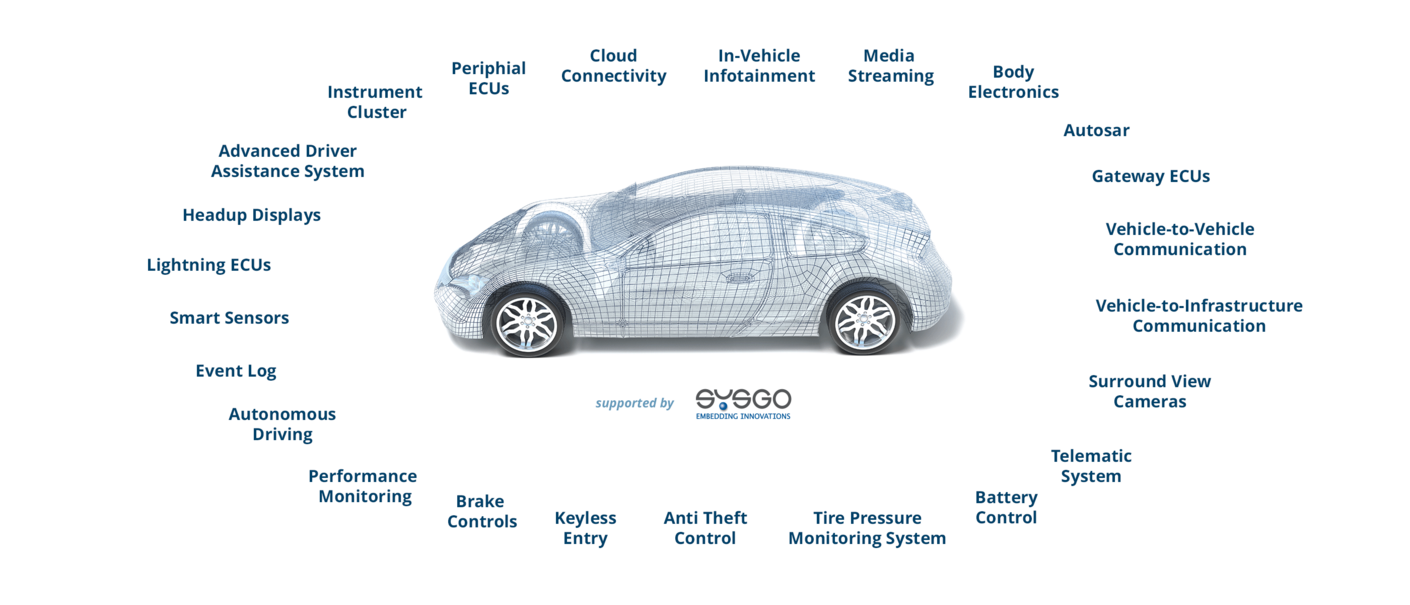Automotive
Embedded Automotive Software Safety & Security
The Automotive industry is currently under a heavy change process. Coming from an engineered mechanic vehicle, automobiles nowadays become more and more rolling networked devices. Innovation is driven by software while the need for Safety is constantly high and the call for Security is heavily increasing. Our solutions address the highest demands for Safety and Cyber Security and deliver a comprehensive base for the next generation's mobility.
SACoP - Secure Automotive Connectivity Platform

The Automotive industry has come a long way since the first automobile was invented. Today, vehicles are equipped with advanced technologies that ensure not only efficient transportation, but also Safety and Security of passengers and other road users. The integration of real-time systems in vehicles has transformed the industry, enabling sophisticated features such as autonomous driving, collision avoidance, and advanced driver assistance systems.
However, with these advancements come new challenges, including the need for robust Cybersecurity measures to prevent attacks on the increasingly connected and complex vehicle systems. The Automotive industry is continuously striving to improve Safety and Security measures, with real-time technologies playing a crucial role in achieving these goals.

Start the Engine
Joint Webcast: June 22, 2021
Accelerating Avionics Design and Deployment with COTS Solutions
Autonomous Vehicles & ADAS
Autonomous Vehicles and Advanced Driver Assistance Systems (ADAS) refer to the integration of cutting-edge technologies and systems into vehicles to enable advanced functionality and autonomous driving capabilities. ADAS technologies include features which improve driving Safety and comfort. Autonomous vehicles take these capabilities further, allowing for full or partial automation of the driving process, reducing the need for human intervention.

Adaptive Cruise Control
UAVs can be equipped with cameras and other sensors to provide real-time video and data feeds for surveillance and reconnaissance missions.

Lane Departure Warning
UAVs can be used for precision agriculture, mapping fields, and monitoring crop health. They can be equipped with sensors to measure plant health, temperature, and other environmental factors.

Blind Spot Monitoring
UAVs can be deployed in search and rescue missions, covering large areas quickly and providing real-time information to responders.
Traffic Flow and Fuel Efficiency
UAVs can be used to monitor environmental conditions, such as air and water quality, to detect and respond to environmental disasters and other events.
Electric & Hybrid Vehicles
Electric and hybrid vehicles refer to vehicles that run on electric power or a combination of electric power and traditional internal combustion engines. These vehicles use electric motors and batteries to power the vehicle, reducing the reliance on gasoline or diesel fuel and leading to lower emissions and improved fuel efficiency. Electric and hybrid vehicles are becoming increasingly popular due to their environmental benefits, cost savings, and the advances in technology that allow for longer driving ranges and faster charging times. The use of these vehicles is a crucial step towards sustainable transportation and reducing the carbon footprint of the Automotive industry.

Electric Vehicle Charging Infrastructure Expansion for Long-Distance Travel
As the demand for electric vehicles continues to grow, the need for charging infrastructure to support long-distance travel becomes more pressing. This use case explores the development of electric vehicle charging stations in remote areas and along highways to ensure EV drivers can travel long distances without range anxiety.

Smart Charging for Electric Vehicles
To optimize the use of energy resources and reduce charging costs, this use case focuses on smart charging for electric vehicles. Smart charging involves charging EVs during periods of low electricity demand and leveraging renewable energy sources such as solar and wind to power EV charging stations.

Electric Buses for Public Transportation
Electric buses are an environmentally friendly alternative to traditional diesel-powered buses. This use case examines the implementation of electric buses in public transportation systems to reduce emissions, lower maintenance costs, and improve air quality in urban areas.
Wireless Charging for Electric Vehicles
Wireless charging technology has the potential to revolutionize the electric vehicle market by making charging more convenient and accessible. This use case explores the development of wireless charging technology for electric vehicles, enabling drivers to charge their cars simply by parking in designated areas.
Hybrid Electric Vehicles for Fuel Efficiency
Hybrid electric vehicles (HEVs) combine an internal combustion engine with an electric motor, providing improved fuel efficiency and reduced emissions. This use case examines the implementation of HEVs in fleets such as taxis and delivery trucks, reducing fuel consumption and emissions while maintaining operational efficiency.
Electric Vehicle Battery Recycling
As the number of electric vehicles on the road increases, so does the need for proper disposal and recycling of batteries. This use case explores the development of electric vehicle battery recycling programs to recover valuable materials and reduce environmental impact.
Connected Cars & V2V Communication
Connected Cars and Vehicle-to-Vehicle (V2V) Communication refers to the integration of wireless communication technology to allow for real-time information exchange between vehicles. This technology enables vehicles to share data about their location, speed, and other driving-related information with each other, improving road safety and traffic efficiency. In a V2V communication system, vehicles are equipped with specialized communication devices that use short-range wireless connections to exchange information. The technology has the potential to reduce traffic accidents by providing drivers with warnings about potential hazards and allowing vehicles to collaborate in avoiding collisions.
Enabling Autonomous Driving
UAVs can be used to inspect bridges, pipelines, power lines, and other infrastructure, reducing the need for manual inspections and improving Safety.
Enhancing Safety on the Roads
UAVs can be used for delivery of goods and medical supplies in hard-to-reach areas or in emergency situations. They can be equipped with sensors to detect obstacles and ensure safe delivery.

Reduction of Traffic Accidents
UAVs can be equipped with cameras and other sensors to provide real-time video and data feeds for surveillance and reconnaissance missions.

Traffic Management Systems
UAVs can be used for precision agriculture, mapping fields, and monitoring crop health. They can be equipped with sensors to measure plant health, temperature, and other environmental factors.

Real-Time Monitoring for Predictive Maintenance
UAVs can be deployed in search and rescue missions, covering large areas quickly and providing real-time information to responders.
Optimizing Energy Efficiency
UAVs can be used to monitor environmental conditions, such as air and water quality, to detect and respond to environmental disasters and other events.
Vehicle Safety & Cybersecurity
This crucial aspect of the Automotive industry is particularly important within the increasing use of technology and connectivity in vehicles. The area focuses on ensuring the Safety of passengers and other road users, as well as protecting the vehicle's systems and data from potential cyber threats. This includes designing and implementing systems and technologies that cover measures to prevent hacking and unauthorized access, ensuring safe operation and protection of sensitive data.

Securing Connected Cars: Ensuring Safety and Preventing Cyberattacks
As cars become more connected, the risk of cyberattacks increases. This use case focuses on implementing cybersecurity measures to protect connected cars from hacking and unauthorized access, ensuring the safety of drivers and passengers.

Advanced Driver Assistance Systems (ADAS): Enhancing Vehicle Safety
ADAS technologies such as automatic emergency braking, lane departure warnings, and adaptive cruise control are designed to prevent accidents and save lives. This use case focuses on the implementation and integration of ADAS systems to enhance vehicle safety and prevent collisions.

Real-time Monitoring and Analysis of Vehicle Data for Proactive Maintenance and Safety
By leveraging sensors and data analytics, this use case aims to enable real-time monitoring of a vehicle's health and performance. This allows for proactive maintenance and can prevent safety issues from developing or worsening.
Protecting Vehicle Communications with secure V2X Communication
V2X (Vehicle-to-Everything) communication allows for improved safety and efficiency on the road, but it also presents security risks. This use case focuses on implementing secure V2X communication to protect against cyberattacks and ensure the safety of drivers and passengers.
Infotainment & Human-Machine Interface (HMI)
Infotainment and Human-Machine Interface (HMI) are important aspects of modern Automotive design. Infotainment refers to the system that provides entertainment and information to the driver and passengers, including features such as music, navigation, and communication. HMI refers to the way in which the driver interacts with the vehicle and its systems, including the dashboard, touchscreen display, and voice commands. The design of both infotainment and HMI systems is crucial for providing a safe and enjoyable driving experience, as well as enabling drivers to easily access the information they need while on the road. In this context, real-time capabilities play a critical role in ensuring that these systems operate smoothly and without interruption, providing drivers with reliable and intuitive interfaces.

Voice-activated Infotainment System while Driving
UAVs can be equipped with cameras and other sensors to provide real-time video and data feeds for surveillance and reconnaissance missions.

Gesture Control for Infotainment Systems
UAVs can be used for precision agriculture, mapping fields, and monitoring crop health. They can be equipped with sensors to measure plant health, temperature, and other environmental factors.

Augmented Reality Windshield with digital Information
UAVs can be deployed in search and rescue missions, covering large areas quickly and providing real-time information to responders.
Personalized Driver Profiles for Multiple Users
UAVs can be used to monitor environmental conditions, such as air and water quality, to detect and respond to environmental disasters and other events.
Touchscreen Displays with haptic Feedback
UAVs can be used to inspect bridges, pipelines, power lines, and other infrastructure, reducing the need for manual inspections and improving Safety.
Advanced Navigation Systems with real-time Traffic Information
UAVs can be used for delivery of goods and medical supplies in hard-to-reach areas or in emergency situations. They can be equipped with sensors to detect obstacles and ensure safe delivery.
Automotive Complexity
Manage real-time challenges with safe and secure virtualization
Videos & Webcasts








Functional Safety
We provide solutions that are comprehensibly and well manageably certifiable up to ISO 26262 ASIL D. In addition, embedded Automotive software also benefits from the very strict Safety pre-certification of our technology according to the DO-178 Avionics standard.
Security
The PikeOS separation kernel itself is small in terms of implementation and its little number of system calls allows comprehensive evaluation and validation. As a matter of fact, PikeOS 5.1.3 (x86 64-bit, ARMv8, PowerPC) has passed the Common Criteria EAL5+ certification.

Customer & Partner Voices
Partner Voice
Targeting extremely critical embedded applications in the avionics, automotive, railway, and other industries, SYSGO is a perfect fit for our proven security technologies. We are happy to work with the European leader, giving us additional presence on the continent and worldwide.
Larry Stefonic
CEO at wolfSSL
Partner Voice
SYSGO’s PikeOS 5 expands capability of NXPs popular i.MX 8X family of applications processors for the high demands of critical embedded system infrastructure in industrial automation, automotive, railway and avionics,” commented Ron Martino, Senior Vice President and General Manager, Edge Processing Business, NXP Semiconductors. “Automotive and Industrial Transportation systems can leverage the hardware separation capability and safe OS to achieve reliable systems that are critical for the safety of the users.
Ron Martino
Senior Vice President and General Manager at NXP Semiconductors
Edge Processing Business
Partner Voice
More and more, we are seeing vehicles becoming interconnected with software, and open to the movement of data. ADAS systems and IVIs are great examples of this trend. Such levels of data use require storage software that is both fast-acting and stable. Through this partnership with SYSGO, we are confident that automotive file system storage will reach a new level of performance and security. The cooperation also expands our ecosystem to support safe and secure embedded systems.
Bernd Niedermeier
Sales Director of Automotive at Tuxera
Partner Voice
We have been developing a virtualization technology for our V850 architecture to enable control of multiple systems with a single CPU core without mutual interference, allowing high speed and composite control in fields such as industrial machinery and automotive systems, where real-time control is essential. This collaboration with SYSGO enables us to achieve more scalable CPU architecture and to provide virtualization technology that supports our customers in building more flexible development systems.
Michiya Nakamura
General Manager at Renesas Electronics Corporation
1st MCU Business Division
Partner Voice
The upcoming automotive change in vehicular networks will require much more speed [...] in building our technology while elevating security, safety and compliance with new regulations which we predict will be required for the new era of mobility. Partnering with SYSGO and their high integrity OS as well as their conformity with the strict requirements of aerospace integrations, fits perfectly with our comprehensive, uncompromising security approach. This is the reason why we chose SYSGO as part of our multi-domain’s management logic.
Orit Shifman
Group CEO and Founder of OSR
Customer Voice
Individualisation is an important trend in automobile production. PikeOS, certifiable according to the automotive electronics safety standard ISO 26262, is the ideal solution for us. Using the Hypervisor allows us to be very flexible in the functional composition of our platform. We enable our customers to quickly and efficiently implement innovative functions via software, even in the after sales market, as well as to meet the highest safety requirements.
Dr. Christian Buckl
Software Development Manager at Siemens CT NTF RACE
Partner Voice
Thanks to the high quality standard of SYSGO's technology, we can provide automotive manufacturers and their suppliers with a universal operating system that bridges the gap between consumer electronics and modern automotive electronics while meeting the safety-oriented requirements of the aviation industry.
Rolf Morich
General Manager at OpenSynergy
Partner Voice
Cybersecurity and safety-critical systems are part of the Thales DNA. For us, this joint initiative with Vector and SYSGO is a natural step beyond what we already do for the automotive industry in cybersecurity services and consulting.
Laurent Maury
Vice-President, Critical Information Systems and Cybersecurity, Thales
Customer Benefits
Reduced Complexity saves Weight, Energy, Space and Costs
PikeOS enables integration of a large number of electronic devices onto a single hardware platform.
Secure Communication protects Subsystems
Strict separation of applications into secure partitions allows authorized access only and avoids mutual interference.
Integrated Safety reduces Certification Cost
Applications of various levels of criticality and Security are separated from each other and can be certified separately.
Support for Automotive Standards meets Industry Needs
PikeOS supports AUTOSAR, CAN, AGL or COVESA
High Scalability and Hardware Independence secure Investment
PikeOS allows legacy code re-use and reduces system boot-up time.






